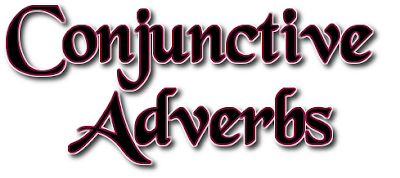Connecting adverbs are often used to show the relationship between the ideas expressed in a clause and the ideas expressed in a preceding clause, sentence or paragraph. In the following examples, the connecting adverbs are printed in bold type.
e.g. I wanted to study; however, I was too tired.
We knew what to expect. Therefore, we were not surprised at what happened.
In the first example, the connecting adverb however shows that there is a conflict between the idea expressed in the clause I was too tired and the idea expressed in the preceding clause I wanted to study. In the second example, the connecting adverb therefore shows that there is a cause and effect relationship between the idea expressed in the sentence we knew what to expect, and the clause we were not surprised at what happened.
Connecting adverbs are similar to conjunctions in that both may be used to introduce clauses. However, the use of connecting adverbs differs from that of conjunctions in the ways indicated below.
a. Stress and punctuation
In spoken English, a connecting adverb is usually given more stress than a conjunction. Correspondingly, in formal written English a connecting adverb is usually separated from the rest of a clause by commas, whereas a conjunction is usually not separated from the rest of a clause by commas.
In addition, in formal written English a clause containing a connecting adverb is often separated from a preceding clause by a semicolon; whereas a clause beginning with a conjunction is usually not separated from a preceding clause by a semicolon.
e.g. I wanted to study; however, I was too tired.
I wanted to study, but I was too tired.
In the first example, the connecting adverb however is preceded by a semicolon, and is separated from I was too tired by a comma. In the second example, the conjunction but is preceded by a comma rather than by a semicolon, and is not separated from I was too tired by a comma.
It should be noted that when no conjunction is present, a semicolon may be used to connect two main clauses. For example:
The clouds dispersed; the moon rose.
In this example, the two main clauses the clouds dispersed and the moon rose are connected by a semicolon rather than by a conjunction.
b. Connecting adverbs used to connect sentences
Unlike conjunctions, connecting adverbs may be used in formal English to show the relationship between ideas expressed in separate sentences. For example:
The wind was strong. Thus, I felt very cold.
In this example, the connecting adverb thus shows that there is a cause and effect relationship between the ideas expressed by the two sentences the wind was strong and I felt very cold.
In informal English, coordinate conjunctions are sometimes used to show the relationship between the ideas expressed in separate sentences. For example:
The wind was strong. And I felt very cold.
However, this use of coordinate conjunctions is considered to be grammatically incorrect in formal English.
c. Position in a clause
A subordinate conjunction must usually be placed at the beginning of a clause. However, as was seen in the discussion on adverbs, a connecting adverb may be placed at the beginning, in the middle, or at the end of a clause. This is illustrated below.
e.g. His visit was unexpected. Nevertheless, I was pleased to see him.
His visit was unexpected. I was, nevertheless, pleased to see him.
His visit was unexpected. I was pleased to see him, nevertheless.
d. Examples of connecting adverbs
The following are examples of words which may be used as connecting adverbs. Each connecting adverb is followed by its meaning and an example of its use.
| accordingly: so | He was very persuasive; accordingly, I did what he asked. |
| also: in addition | She is my neighbor; she is also my best friend. |
| besides: in addition | I like the job. Besides, I need the money. |
| consequently: so | She had a fever; consequently, she stayed at home. |
| furthermore: in addition | You should stop smoking. Furthermore, you should do it at once! |
| hence: for that reason | He is a good friend. Hence, I was not embarrassed to ask him for help. |
| however: but | We wanted to arrive on time; however, we were delayed by traffic. |
| likewise: in addition | The region is beautiful. Likewise, the climate is excellent. |
| moreover: in addition | She is very intelligent; moreover, she is very ambitious. |
| nevertheless: but | They are proud. Nevertheless, I like them. |
| nonetheless: but | The ascent was dangerous. Nonetheless, he decided to attempt it. |
| otherwise: if not, or else | We should consult them; otherwise, they may be upset. |
| still: but | It is a long way to the beach. Still, it is a fine day to go swimming. |
| then: 1. next, afterwards | We went shopping, then we had lunch. |
| 2. so | If you are sure, then I must believe you. |
| therefore: for that reason | I was nervous; therefore, I could not do my best. |
| thus: so, in this way | He travelled as quickly as possible. Thus, he reached Boston the next day. |
As indicated in the following table, several connecting adverbs have meanings similar to those of the conjunctions and, but or so.
| Similar to And | Similar to But | Similar to So |
| also | however | accordingly |
| besides | nevertheless | consequently |
| furthermore | nonetheless | hence |
| likewise | still | therefore |
| moreover | thus |
Any broken links, queries, requests? Please, let us know! englishdailyworkout@gmail.com














No comments:
Post a Comment
Comments